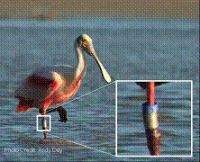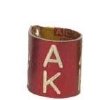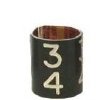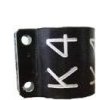B. Report Band Information
An aluminum band from the USGS Bird Banding Laboratory is used on all banded birds. This band is aluminum (silver) in color and is placed on the tarsus (just above the feet). The USGS band will always be on the opposite leg of any other bands present. The code on this band is not intended to be read from a distance, but rather to identify the bird if it is ever recaptured or recovered.
In addition to the USGS band, one or more colored bands may have been placed on the tibia (above what appears to be the "knee") of the opposite leg, so that the bands may be observed while the bird is foraging in shallow water. These colored bands may be metal with an alphanumeric code, PVC with an alphanumeric code, or plastic without an alphanumeric code.
Examples of all bands:

Please note that if a plain, colored plastic band is present, it will always be paired with a colored metal alphanumeric band (located above the alphanumeric band, on the same leg, as in the photo below). Therefore, if you see two bands on the same leg, they are likely a metal alphanumeric band paired with a non-alphanumeric (plain) colored plastic band. As you can see from the photo below, the metal alphanumeric bands have faded in the spoonbill’s saltwater habitat, which is why birds banded beginning in the 2008-09 nesting season wear PVC bands.
 More color options are available in the PVC bands and therefore the plain colored plastic bands will no longer be used. Because of these changes, detailed information regarding the type of band(s) you observed and whether or not a band appeared faded are essential. For example, the bird in the photo to the right has a plain, blue plastic band over a very faded metal alphanumeric band that appears to have been black originally.
More color options are available in the PVC bands and therefore the plain colored plastic bands will no longer be used. Because of these changes, detailed information regarding the type of band(s) you observed and whether or not a band appeared faded are essential. For example, the bird in the photo to the right has a plain, blue plastic band over a very faded metal alphanumeric band that appears to have been black originally.
1. What type of bands did you observe?
2. Report specific information on the alphanumeric band
- If you observed a band with an alphanumeric code, what was the color?
- How certain are you of the color?
certain reasonably sure not sure
- Which leg was the alphanumeric band on?
right left not sure
- How certain are you about which leg the band was on?
certain reasonably sure not sure
- Was the lettering on the band vertical or horizontal?
Vertical  or
or
Horizontal 
not sure
- Could you read the alphanumeric code?
yes no partially
- If so, please enter the code or partial code in the text box:
- How certain are you of the alphanumeric code?
certain reasonably sure not sure
3. Bands without an alphanumeric code (if present)
- If you observed a colored band without an alphanumeric code, what color was it?
- How certain are you of the color?
certain reasonably sure not sure
4. Date, time, and location of sighting
- What was the date of your sighting? (e.g. MM/DD/YY)
- What was the time of your sighting? (e.g. 3 PM)
- In what county was the bird observed?
- Where was the bird located? Be as specific as possible.
Examples: "Florida Bay" is helpful, "near Lignum Vitae Key in Florida Bay" is more helpful, "the mud flat 100 yards south of Lignum Vitae Key in Florida Bay" is very helpful.
- Enter the coordinates if you have them (e.g. latitude/longitude):
- Metric for the coordinates (if none, leave blank)
If other, please specify
- How were the coordinates acquired?
If other, please specify
5. Observer Background
-
If other, please specify
6. Comments
Please describe any additional information you wish to convey (e.g., behaviors, unusual circumstances, plumage, etc).
STEP 3: Submit Form
Please double check the entered information before clicking the "SUBMIT YOUR SIGHTING" button below.
Please submit only one form per spoonbill sighted.
Return to this page to submit additional sightings.
* All form fields are required.
Thank you for participating. Your sighting will help us to protect spoonbills and their habitat.
For additional information, please contact Audubon of Florida at either of the following centers:
Tavernier Science Center
115 Indian Mound Trail
Tavernier, FL 33070
(305) 852-5318 |
Florida Coastal Islands Sanctuaries
410 S. Ware Boulevard, #702
Tampa, FL 33619
(813) 623-6826 |
 |
 |

